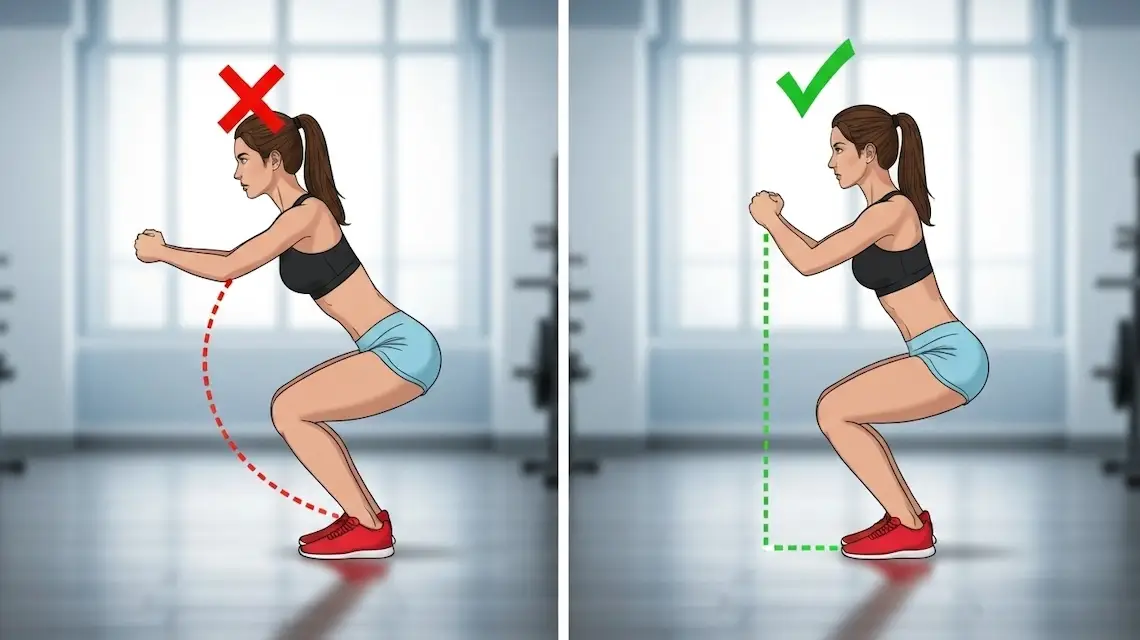Starting a new fitness routine is exciting, but even small missteps can hold you back or set you up for injury. Avoiding common workout mistakes is key to getting better results, feeling stronger, and keeping workouts fun. When you know what to watch for, you can train smarter, stay motivated, and protect your body for the long term.
This post breaks down the most common workout mistakes and how to avoid them, with clear tips you can use right away. Whether you want safer routines or better progress each week, you’ll find advice that makes sense for every fitness level. If you struggle with specific pain, like knee pain, you might also like these targeted knee pain workouts designed to help you move comfortably and avoid common pitfalls.
Mistake #1: Poor Technique and Form
You can spend hours at the gym, but if your technique is off, progress stalls and injury risk rises. Among the most common workout mistakes and how to avoid them, poor form quietly undermines your hard work. It’s like trying to build a house on a shaky foundation—sooner or later, things will go sideways. Understanding why form matters, how to spot problems, and what to do about it will set you up for steady improvement and a safer, stronger body.
Why Proper Form Matters
Proper form is the backbone of any effective workout. If your movements are sloppy or rushed, you may be:
- Putting extra strain on joints and muscles
- Building bad habits that limit long-term progress
- Missing out on muscle engagement, which makes your efforts less efficient
- Increasing your risk of pulled muscles, sprains, and overuse injuries
Poor technique also hinders results. The most dedicated workouts can hit a plateau when your body compensates for bad movements rather than gaining strength where you want it. Even workouts meant to boost overall health, like walking or resistance training—depend on good form. Bad habits developed here can actually weaken posture or trigger chronic pain over time, which may even impact your exercise and immune system.
How to Recognize and Correct Bad Technique
Spotting mistakes early keeps small errors from becoming serious setbacks. Listen to your body—if a movement feels awkward, painful, or way too easy, you might not be moving correctly. Here’s how to get in front of bad technique:
- Watch yourself in a mirror or record videos during workouts. If something looks off, it probably is.
- Notice consistent soreness in areas unrelated to the target muscles.
- If you struggle to complete reps with control, form may be breaking down from fatigue.
Once you identify problem areas:
- Slow down: Quality before quantity always wins. Reset between reps if you need to.
- Educate yourself: Watching credible trainers break down movements online can be helpful.
- Use feedback: Ask a knowledgeable friend, personal trainer, or join a reputable class for hands-on cues.
- Start light: Use bodyweight or minimal resistance until you can move through the full range of motion smoothly.
Tips for Maintaining Good Form Across Exercises
Good form isn’t just about rigid rules. It’s a dynamic process where details matter—how you breathe, focus, and control each repetition makes a difference. Yoga, for example, treats every movement as a chance to create good habits in body awareness and breathwork. If you want to see how powerful those principles are in practice, check out these benefits of yoga for staying fit.
Here are simple ways to keep your form sharp, no matter what kind of workout you do:
- Warm Up Wisely: Loosen up joints and activate muscles to prepare for clean movement patterns.
- Set up Your Stance: Always know your starting position. Shoulders back, core braced, feet planted.
- Move With Intention: Don’t rush. Focus on muscle engagement and smooth, controlled motions.
- Use Breathwork: Inhale on the easier part of a movement, exhale on exertion. This cue, borrowed from yoga, helps you stay mindful, steady, and strong.
- Check In With Yourself: Quick self-audits during sets (Am I slouching? Is my core tight?) prevent drift into lazy patterns.
- Rest When Needed: Fatigue is the fastest way to lose good form, so schedule breaks and listen to your body.
By rooting your routine in good technique and self-awareness, you avoid one of the most common workout mistakes and set yourself up for better performance, fewer aches, and real long-term gains.
Mistake #2: Neglecting Warm-Ups, Cool Downs, and Recovery
Skipping warm-ups, cool downs, and recovery might seem like you’re saving time, but you’re actually cutting corners on safety and results. The body is like a high-performance engine that needs time to get going and slow down. Ignore these crucial steps, and you invite nagging aches, slower progress, and unexpected injuries. Let’s break down why these phases of your workout matter, and how you can make small changes to avoid one of the most common workout mistakes and how to avoid them.
The Role of Warm-Ups in Preventing Injury
A good warm-up is your body’s green light before pushing the pace. When you ease into activity, you gently raise your heart rate and boost circulation to your muscles, joints, and connective tissues.
Here’s what a solid warm-up does for you:
- Loosens tight muscles, reducing strain and injury risk
- Prepares joints for bigger ranges of motion
- Helps you mentally shift gears from rest mode to workout mode
You don’t need to overthink it. Five to ten minutes of light movement—like brisk walking, arm circles, or jumping jacks, can make all the difference. Check out these posture improvement exercises for practical warm-up ideas that also support joint health.
The warm-up is where you lay the foundation for every rep. Skipping this step is like trying to drive on a frosty morning without letting the car defrost—things can go wrong quickly.
Cool Downs and Active Recovery
A cool down is more than a time to catch your breath. It’s how you help your body reset after hard work.
The cool down:
- Lowers your heart rate gradually
- Helps move waste products, such as lactic acid, out of your muscles
- Reduces muscle tightness and soreness
Think of it as a gentle landing after a flight. This is the best time for easy stretches—focus on areas worked the most, like hamstrings, calves, and shoulders. Simple moves like walking at a slower pace or doing gentle stretching for five minutes work well.
Active recovery can also include activities like yoga or a slow bike ride. These low-intensity sessions help boost blood flow without adding extra stress. A good cool down helps to prevent next-day stiffness, which can sneak up after a tough workout.
Optimizing Recovery: Nutrition and Rest
Your muscles don’t get stronger during the workout—they get stronger during recovery. Skimping on downtime leads to fatigue, nagging pain, and plateaued results.
Key recovery habits include:
- Quality sleep: Aim for 7 to 9 hours to help your body repair muscle microtears and balance hormones.
- Smart nutrition: Eat a mix of protein and carbs after exercise to help muscles rebuild.
- Hydration: Water helps flush out toxins and aids muscle function.
Strategic rest days keep you improving. It’s easy to ignore, but proper recovery helps you return stronger for your next session. Active adults also benefit from learning about the magnesium benefits for muscle recovery, since this mineral plays a role in muscle repair and relaxation.
Failing to rest and refuel is one of the most overlooked common workout mistakes and how to avoid them. Make time for these recovery basics and you’ll notice more energy, better progress, and fewer aches down the line.
Mistake #3: Overtraining and Lack of Programming
Jumping into workouts with full force feels empowering, but doing too much too soon or skipping a logical plan is one of the most common workout mistakes and how to avoid them is to respect the need for both challenge and rest. Your body has limits, and ignoring them can actually set you back or keep you stuck at a plateau. Balance, patience, and a thoughtful approach are just as important in the gym as motivation and energy.
Symptoms and Dangers of Overtraining
Overtraining happens when you push your body hard, too often, without enough recovery. Instead of making steady gains, you start to feel run-down and weak.
Watch for these warning signs:
- A sudden drop in performance, despite working harder
- Constant fatigue, heaviness, or trouble sleeping
- Frequent aches, soreness, or injuries that don’t heal
- Mood swings, irritability, or loss of motivation
- Lingering colds or a weakened immune system
Ignoring these signals is like driving a car with the “check engine” light on. You risk burnout, chronic injury, or even issues with your immune system and workout recovery. If your immune health takes a hit, you may want to learn ways to boost immune system naturally so your body can bounce back better.
Building a Balanced Workout Program
Having a plan is your best defense against overtraining and wasted effort. A balanced workout program builds strength, endurance, and mobility while giving your body time to recover and grow.
To set up a smart plan:
- Mix strength, cardio, and flexibility training each week.
- Schedule at least one full rest day to let your muscles repair.
- Plan gradual progress: increase intensity or volume by about 10 percent per week—not all at once.
- Rotate muscle groups, so you’re not hitting the same areas day after day.
- Take deload weeks—a lighter week every 4 to 8 weeks—to allow for deeper recovery.
Breaking up workouts into focused sessions can keep you growing strong without wearing your body down. Think of programming like a recipe: the right mix keeps results coming while letting you enjoy the process.
Listening to Your Body and Adjusting
No app or program knows your body better than you. Learning to read your own signals is a powerful tool to avoid setbacks.
Here’s how to stay in tune:
- Track your energy and mood daily; dullness or dread means it’s time to pull back.
- If you notice chronic pain, disrupt your routine with a day off or active recovery.
- Accept rest as a key part of your program, not a “reward.” Recovery days are when your muscles repair and grow.
- Adjust your schedule when life gets busy or stress pops up. Missing a workout is better than getting injured or sick.
Remember, the best results come from consistent, thoughtful work over time—not from punishing yourself day in and day out. Listening to your own body, especially when it whispers for rest, is how you build lifelong strength and avoid the pitfalls of overtraining.
Mistake #4: Ignoring Individual Needs and Specific Limitations
No two bodies move, heal, or respond to workouts in exactly the same way. One of the most repeated common workout mistakes and how to avoid them is treating every fitness plan as if it were one-size-fits-all. What works for a seasoned runner may strain someone with joint issues or old injuries. Your workout should support your unique build, flexibility, health history, and even day-to-day aches. Ignoring these differences can slow progress or make problems worse, especially for anyone with knee pain, old injuries, or chronic conditions. Adapting your routine isn’t just smart—it’s necessary for safety, comfort, and real results.
Customizing Workouts for Your Body
Workouts should fit you, not the other way around. Bodies come in all shapes and sizes, and life experience shapes how your muscles move. Maybe you have stiff hips from a desk job, or your shoulders ache from old sports injuries. If you don’t adjust for these differences, it’s like wearing shoes that don’t fit—the discomfort builds up fast.
To keep workouts pain-free and productive:
- Take stock of your daily habits, any chronic pain, or medical history before starting a new exercise.
- Focus on quality movement before adding extra weight or speed.
- Pick exercises that respect your natural range of motion.
- Use props or supports when needed, like yoga blocks or resistance bands.
Common Mistakes for Specific Body Areas
Each part of the body has its pain points and weaknesses, especially if you’ve been active for years or are just starting out. Ignoring these doesn’t just stall progress—it often causes little problems to grow.
Here’s where people go wrong most often:
- Shoulders: Lifting too heavy too soon or using poor posture can cause pinching or rotator cuff strain.
- Back: Twisting with weights or skipping core work can make lower back pain stick around longer.
- Knees: Deep squats or running too much, too soon, without addressing form magnifies knee discomfort or old injuries.
To protect these areas:
- Warm up each body part before intense exercise.
- Choose the right movement for your flexibility and joint health.
- Listen to slight aches or sharp pains as warnings, not challenges.
By honing in on your tricky spots and giving them a little extra care, you avoid the trap of repeating common workout mistakes and how to avoid them applies just as much to specific areas as it does your overall plan.
Consulting Professionals and Using Modifications
Sometimes it’s tough to know what modifications will help or how to handle stubborn pain. That’s when asking for professional guidance pays off. A personal trainer, physical therapist, or knowledgeable group instructor can spot problems and show you better options.
Get personalized advice if you:
- Have a new diagnosis or injury.
- Keep feeling pain in the same spot after workouts.
- Aren’t sure if your movement is right for your body shape or limitations.
Simple modifications, like swapping out lunges for glute bridges or reducing range of motion, make a world of difference. Props, bands, and supports turn intimidating moves into accessible ones. Don’t see modifications as a step back—they’re tools to help you stay healthy and consistent.
Ignoring your own needs is like trying to drive with a tire that’s a bit flat. The longer you push it, the bumpier the road feels. Take time to learn your body’s signals, ask for help when you need it, and make smart tweaks so fitness keeps lifting you up, not holding you back.
Conclusion
Recognizing and avoiding the most common workout mistakes gives you a better shot at real progress, fewer aches, and much more enjoyment from your routine. Small decisions, like focusing on your form or giving your body time to rest, pay off with stronger results and lower risk for setbacks. Growth in fitness is not about being perfect, but about learning and making smart changes as you go.
Stay open to fine-tuning your approach and remember that healthy habits stick best when you adapt them to your body and goals. If you need more help tailoring workouts, these exercises for lower back pain offer targeted support for staying comfortable and strong, especially if back pain is holding you back.
Thanks for spending your time here. Share your own lessons or tips in the comments, your experience could help someone else skip the same mistakes. Keep moving forward, stay curious, and celebrate every step that brings you closer to your fitness goals.
FAQ:
How does skipping warm-ups increase injury risk?
Without warming up, your muscles and joints stay stiff. This can lead to sprains or strains when you start your main workout. Always spend at least 5–10 minutes doing light cardio and dynamic stretching.
Is poor form really that big of a problem?
Yes, it is. Poor form wastes effort and puts stress on your joints and spine. If you’re unsure about your technique, ask a trainer or check trustworthy video guides.
Can you overdo cardio or strength training?
Yes. Too much cardio can lead to fatigue and muscle loss. Lifting too often without rest can cause soreness or injuries. Rest at least one day each week and let muscle groups recover between sessions.
How much rest do muscles need to grow or recover?
Most muscle groups need at least 48 hours of recovery time after a tough workout. Overtraining makes progress stall and might even cause injuries.
Why do people skip leg day and is it a mistake?
Some skip leg workouts because they seem harder or less rewarding. But legs are your largest muscles, so ignoring them slows progress and causes muscle imbalances.
Can working out on an empty stomach be harmful?
It can leave you feeling weak or dizzy, which affects your performance. Eat a small snack with carbs and protein about an hour before you start.
Is sticking to the same routine week after week okay?
Doing the same workout for too long leads to plateaus. Your body gets used to the challenge and stops improving. Change up your exercises or increase resistance every few weeks.
What happens if you don’t stay hydrated during workouts?
You’ll tire out faster, recover slower, and might even feel nauseated or lightheaded. Drink water before, during and after exercise.
How do you know if you’re not eating enough for your training?
Warning signs include low energy, weight loss, slow recovery and feeling rundown. Match your meals to your training intensity and duration.
Why is sleep important for workout results?
Muscle repair, hormone balance and recovery all happen while you sleep. Most adults need 7–9 hours of good sleep each night.
Are supplements needed to avoid workout mistakes?
Supplements aren’t a fix for poor habits. Focus on good nutrition, hydration and rest first. Talk to a doctor before adding any supplements.
Do you have to stretch after a workout?
Stretching helps your muscles relax and can improve flexibility. It may also reduce soreness later. Spend a few minutes on static stretches after each session.



 Importance of Hydration for Your Brain, Body, and Everyday Energy
Importance of Hydration for Your Brain, Body, and Everyday Energy  Beginner Cardio Workout at Home
Beginner Cardio Workout at Home  Healthiest Breakfast Cereal for Children
Healthiest Breakfast Cereal for Children  Anxiety Management Techniques
Anxiety Management Techniques  10 Stretching Exercises to Increase Height
10 Stretching Exercises to Increase Height  What Makes Fat in Our Body?
What Makes Fat in Our Body?